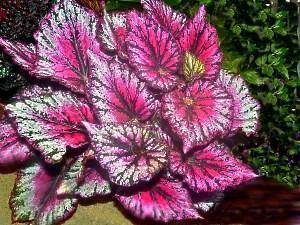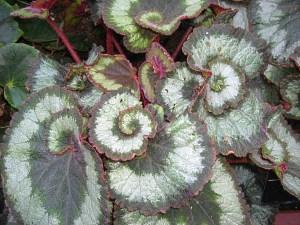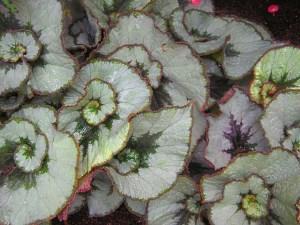Royal begonia - a scattering of colors in one flower
 The genus of begonias is so diverse that the number of varieties of this plant exceeds a thousand. Among them are begonia with a rich royal name. Why royal? This name was given to the plant not only for its magnificent, elegant, sophisticated appearance, but also for its exacting care.
The genus of begonias is so diverse that the number of varieties of this plant exceeds a thousand. Among them are begonia with a rich royal name. Why royal? This name was given to the plant not only for its magnificent, elegant, sophisticated appearance, but also for its exacting care.
Begonias are very capricious and fragile flowers that love light, but not direct ones, scorching the sun's rays; good watering, but not a "swamp" of standing water in the pot. Both too cold and too warm temperatures lead to the fact that royal begonia begins to ache and wither.
The leaves of the royal begonia are quite large, they have different shapes and colors. Usually the veins are in sharp contrast to the lighter background of the leaves, forming bizarre outlines on them. Spots of pink, purple, creamy green, silvery, cherry blossoms flaunt on the leaves, like drops left after the awkward wave of the artist's brush.
Even the inflorescences of this plant look very modest in comparison with the lush and bright leaves. To give growth to the leaves, the inflorescences are often removed. The rhizome of the flower is juicy, fleshy, thickened and spreads over the top layer of the soil, so it makes no sense to start deep pots for a new plant in the house. The homeland of the flower is India and Asia.
In Russia, this flower began to be mentioned in 1812. When the French, frostbitten and ashamed, left the Russian plains, the peasants began to call begonia "Napoleon's ear" for its outward resemblance to a flushed large ear. There is a second, no less funny name for this plant - "elephant ears". A photo of a royal begonia clearly demonstrates this.
Royal begonia care - moderation in everything
What care for a royal begonia is needed so that it blooms its rich, colorful and intricate leaves and lovely inflorescences?
- Begonia is a thermophilic plant, so it is advisable to keep the room temperature between 16 and 22C. It is not recommended to keep flowers on windowsills on the sunny side.
- Moderate, but frequent and regular watering. With an excess of water, the roots of the plant begin to rot - it withers and becomes sick. In summer, you can allow the ground to be slightly damp, and in winter it is advisable to wait until the substrate dries up before the next watering.
- The water must be defended in advance, if it is taken from the tap, and allowed to reach room temperature.
- The optimal level of moisture for a flower is given by the placement of its "home" - a pot in a pallet, at the bottom of which there is water or wet pebbles.
- Royal begonia grows well in soil with medium acidity. It can be a mixture of humus with leaf and sod soil.
- Approximately twice a year, the plant needs additional feeding in the form of mineral fertilizers, but if they are not available, it does not matter, for the normal development and growth of begonias this is not a hindrance. The most suitable organic fertilizer is manure, but it should be allowed to ferment for about 2 weeks. Cow and horse manure needs to be diluted 5 times, and bird droppings as much as 15 times.
- How to care for royal begonia at home? Large leaves of begonia in the summer months become a kind of dust collectors, therefore, in order for the leaves to "breathe", it is advisable to wipe them at least once a month with a dry piece of cloth.
How to propagate royal begonia?
 The most reliable and easiest way is propagation by leaf cuttings
The most reliable and easiest way is propagation by leaf cuttings
After that, the container with cuttings must be covered with polyethylene. Very soon, the cuttings will take root and turn into independent plants. This will happen in about 4 weeks, and after the same amount of time, the cuttings will start up the first leaves. But you can propagate begonia by seeds and by dividing the bush.
The germination of seeds is considered the lowest, since only a quarter of the total number of planted sprouts.
How to transplant?
 Like other indoor flowers, it is better to prepare royal begonias for transplanting in the spring, since the plant fills with vitality and becomes stronger during this period. It is able to quickly adapt to external changes, and accidentally broken roots "rise" to life much faster. If the flower has grown properly over the previous year, then it makes sense to choose a more spacious "house" for it.
Like other indoor flowers, it is better to prepare royal begonias for transplanting in the spring, since the plant fills with vitality and becomes stronger during this period. It is able to quickly adapt to external changes, and accidentally broken roots "rise" to life much faster. If the flower has grown properly over the previous year, then it makes sense to choose a more spacious "house" for it.
Steps for transplanting royal begonia:
- Place the stem between the index and middle finger of your right hand.
- Helping with your left hand, gently turn the pot over.
- If the lump of the substrate has not separated from the walls of the container, ask someone from the family to lightly knock on the bottom of the pot.
- Transfer the flower with soil to a new container.
- Add fresh, fertilized soil as needed.
- If you wish, you can free the root system from the old substrate by carefully removing it around the edges and not touching the central part. This will prevent the roots from breaking.
What diseases should you watch out for?
 Royal begonia is very sensitive to both changes in the external environment and to insufficient care for it. Uninvited guests: spider mites, scale insects, thrips cause her a lot of "suffering". The plant withers and may die if pests are ignored. What should be done?
Royal begonia is very sensitive to both changes in the external environment and to insufficient care for it. Uninvited guests: spider mites, scale insects, thrips cause her a lot of "suffering". The plant withers and may die if pests are ignored. What should be done?
- It is necessary to manually rob begonia from treacherous guests.
- Remove nearby flowers to avoid contamination.
- Make a water and soap solution and water the leaves of the plant with it.
- In advanced cases, the use of insecticides will be advisable.
Flower lovers adore royal begonia for its unusual look, which can decorate any interior and setting. And then: each of the flowers is somewhat different from its "brother". Spots and drawings on leaves can be studied for hours, marveling at the skill of the most skillful artist - Nature, who in this case did not stint either on colors or on the time spent on creating an amazing plant. It is worth looking at a flower once - and then it is impossible to get rid of the desire to become its owner.